More than a wild goose chase
9th November 2024
Pink-footed geese © Martin Hayward Smith
Amanda Loose catches up with a flock of dedicated followers of one of North Norfolk’s most wonderful wildlife spectaculars – the pink-footed geese
The beginning of September and the chatter begins. ‘Have the geese arrived?’ ‘Have you heard them yet?’ And then, you hear it – that wonderful sound as the skeins of geese fly overhead; you stop what you’re doing and dash outside; here they are.
Norfolk is home to numerous species of geese at this time of year, but it’s the ‘pinkfeet’ which steal the show, making the long trip from Iceland to our coastline. Once you’ve seen and heard the wonderful spectacle of the vast numbers of these vociferous birds overhead or ‘whiffling’ down to land to feed on sugar beet tops, it stays with you.
Andy Bloomfield, a warden at Holkham National Nature Reserve, first saw pink-footed geese back in 1982. ‘I always remember one particular day, a really foggy day. I was born at Longlands Farm in Holkham Park and the pinkfeet had all got lost and came to the meadows and grazed by the farm. What captivated me was they sounded of wild places and the Arctic. That was probably the moment that got them into my soul.’ The pink-footed geese stay until early spring, with peak numbers in November and December, says Andy, when sugar beet harvesting is at its peak. As well as watching the geese in his spare time, part of Andy’s job is to estimate numbers: ‘I count them every week for two months in the peak period at the Holkham roost. Numbers are fed into a national database and counts are done in co-ordination with Natural England at Scolt Head and RSPB Snettisham [also major roosts].’ In 2006, there was a count of 90,000, ‘the most we’ve ever had.’ Holkham also plays host to brent geese, 300 white-fronted geese who make the journey from Russia every winter, and others, ‘who are a bit more lost’ says Andy – snow, taiga bean and tundra bean, and red-breasted geese.
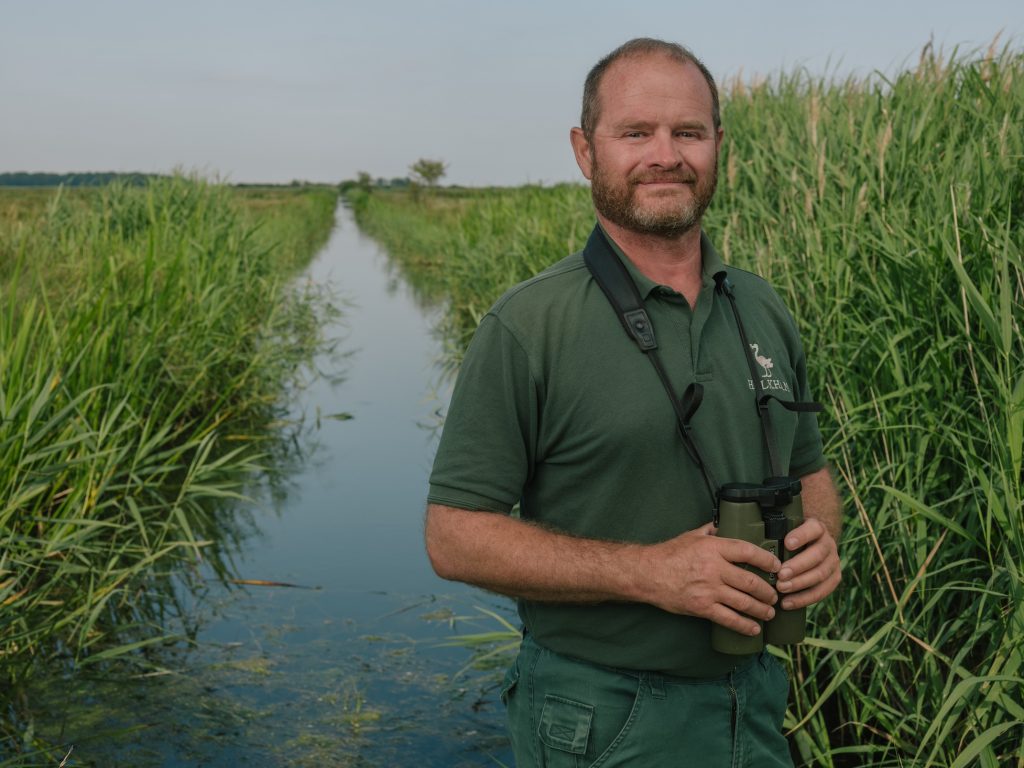
What captivated me was they sounded of wild places and the Arctic. That was probably the moment that got them into my soul.’
Andy Bloomfield
After disturbances during the second world war, the geese fed in the Fens for several decades but started to return to North Norfolk in the 1970s and 1980s, says Andy: ‘There was great euphoria in Wells town, people seeing geese flying over again.
‘I grew up birdwatching with James McCallum at Wells school. I started to get into geese initially and when James came back from art college, we both started watching them together. We followed the same path in a different way, me photographing them and James painting them.’
James takes up the story. ‘I developed an interest in making field paintings of flocks of birds,’ he says. ‘There was so much to learn about the geese – complex relationships of pairs and families within a flock, changing light and colours, the patterns of the skeins passing in front of skyscapes. Even with decades of experience I am constantly learning new things about them.’
James has since written two books about geese in North Norfolk: Wild Goose Winter (now out of print) and Wild Skeins and Winter Skies (available at www.jamesmccallum.co.uk) and spends hours trying to depict the flocks en plein air:
‘It takes a reasonable level of fieldcraft to get into position to paint geese but once the geese accept that the object half concealed in a hedge doesn’t pose much of a threat they slowly begin to relax and can come surprisingly close. When relaxed they continuously make quiet contact calls and the combined noise of thousands of these quiet calls becomes a strange vibrating hum, once you are aware of it, the dominant sound of the feeding flock. The sound instantly ceases if the birds become alarmed. Yet another example of the magic that intimate contact with nature can reveal.’
James’ annual exhibition at Great Walsingham Barns will take place on 16, 17, 23 and 24 November 2024, complete with a selection of his paintings of geese.
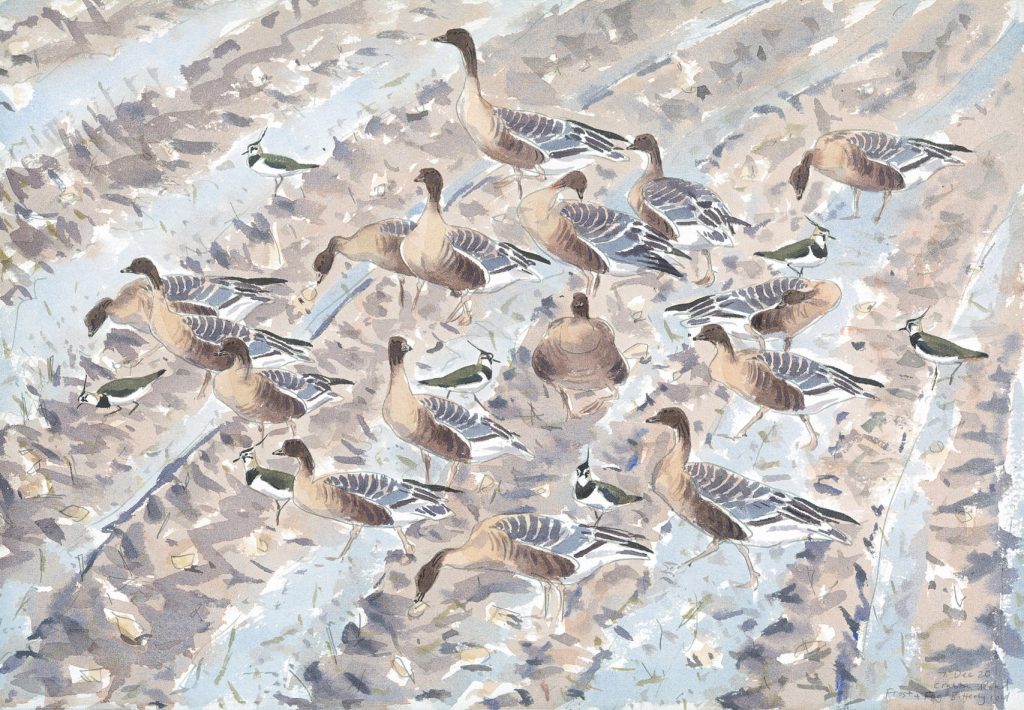
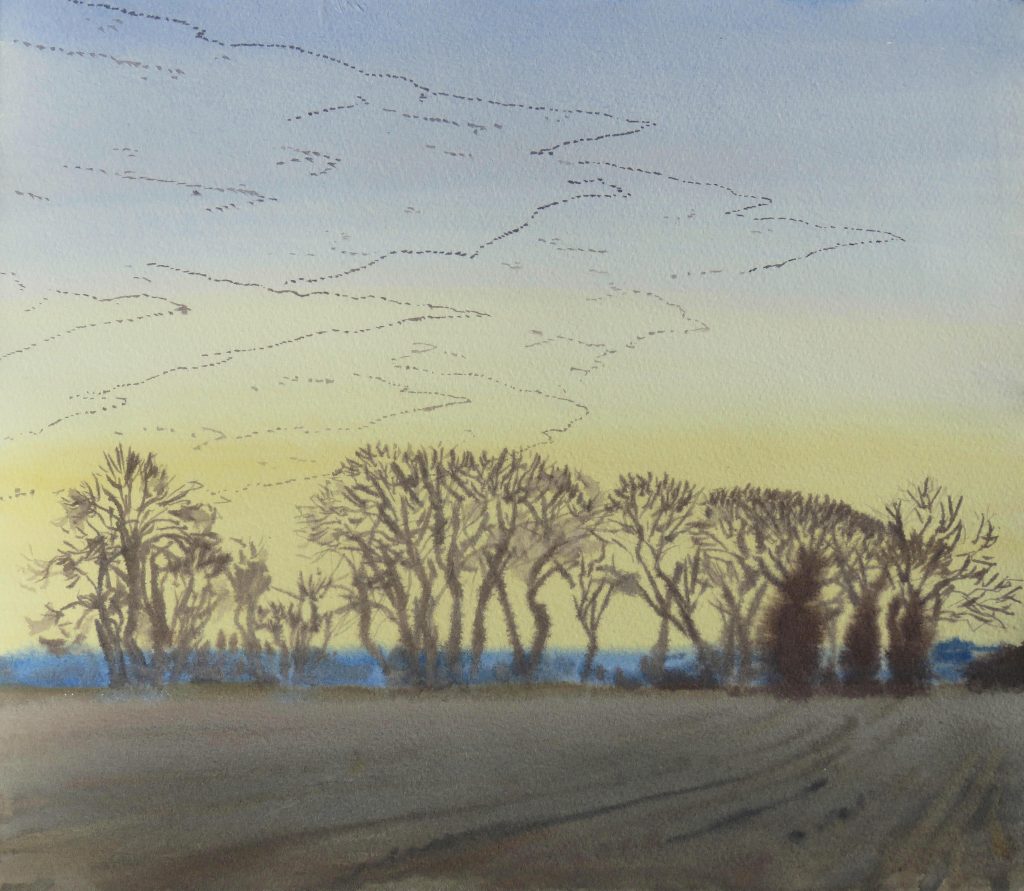
Wildlife cameraman and film director Martin Hayward Smith is another dedicated follower. He runs North Norfolk Safaris, with a ‘Wild Goose Chase Safari’ on offer from late October: ‘I have been following the pink-footed geese for over 40 years, for either filming commissions or personal joy and feel privileged to watch them lift from a coastal roost site at sunrise and follow skeins of sometimes thousands in their v-formation, across vast Norfolk skies. To find a feeding field, where they whiffle down against the wind to find a space amongst thousands of others and the cacophony of their chatter fills me with wonder and a sense of place. They are the embodiment of wild Norfolk at its winter best.’
When Sarah Whittley moved in Cley in 2005, she knew she had to call her gallery Pinkfoot, ‘after the noisy geese.’ She tells me: ‘Since then, every September when the geese return, I’m out most mornings, tracking their movements and chatting with other pinkfooters to see where they’re feeding. My favourite spot is NWT Cley reserve, from Daukes hide, when they come in in their thousands to Simmond’s Scrape and Pat’s Pool to wash and brush up after a long day feeding in muddy beet fields.
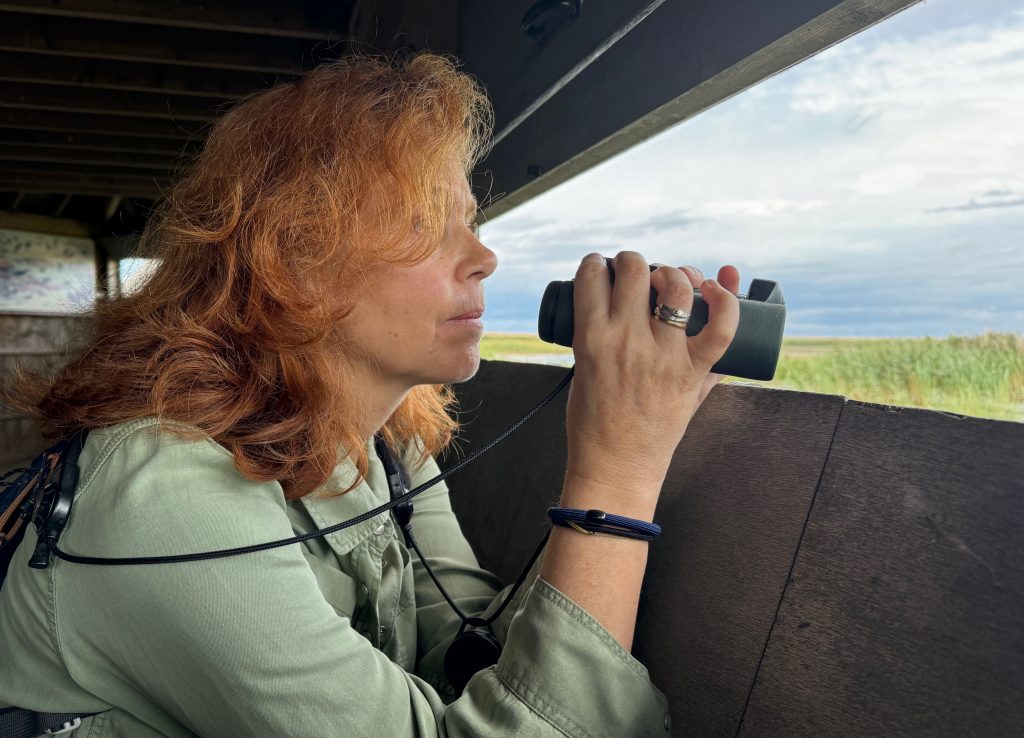
Rhian Lanckmans, a visitor to RSPB Snettisham reserve, agrees. ‘Even on the chilliest of mornings, the sight of thousands of geese silhouetted against an orange sky is enough to stir me from my bed. I’m always moved by the sound of family members calling to each other across the wide expanse of mudflats, it’s as if wingbeat and heartbeat synchronise together high overhead. Parent birds call to their young to keep up as they head inland to feed – it’s really quite emotive.’
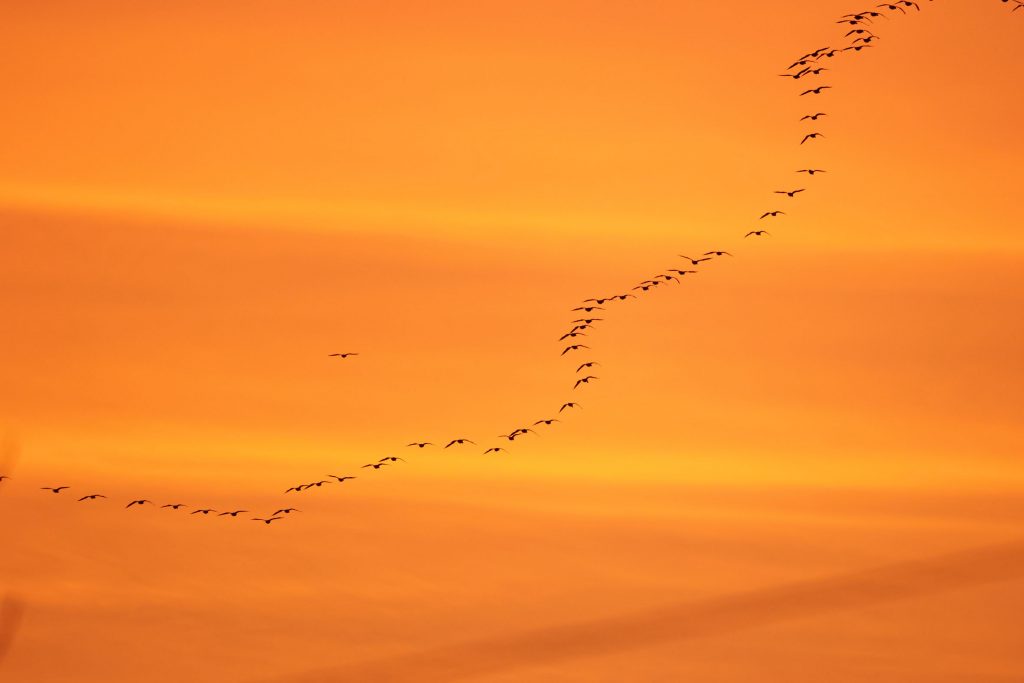
‘When they first return, I feel as excited as the geese sound; I love the description of the geese sounding like cocktail hour at a hen night. Stupidly I worry about those that didn’t make the journey, these tightly knit family groups travel together constantly calling to each other; I imagine them saying ‘Keep up Maud’ or ’Not that way Arthur’.
‘Technology has been a game changer for the local pinkfoot community and indeed for those further away; with apps like what3words and WhatsApp, it’s much easier to keep informed. I know people who plan their visits to Norfolk around the latest sightings hotspots. Eagle-eyed followers make notes on the whereabouts and harvest progress of sugar beet fields. From photographers, artists, birders or just goose fanciers, there’s a growing band of pinkfoot followers – I think it’s only a matter of time before Norfolk sees its first Pinkfoot Festival!’
Wildlife artist Jonathan Yule and his friend, Dr Michael Petch, follow the pink-footed geese in Norfolk and further afield. Reading Peter Scott’s accounts of his visits to Iceland has inspired them to journey to the pinkfeet’s breeding grounds in the mountains of east and north Iceland 23 times.
‘The geese arrive back there in late April/May, often to be met by snow and freezing conditions,’ Jonathan tells me. ‘Pairing for life means that the geese do not need to go through the rigmarole of courtship but can get straight on with breeding. Once their young have hatched, the geese set off, often with many other family groups, to undertake the hazardous journey across the barren upland deserts to wetland areas which provide rich grazing and a degree of safety.
‘It’s a harsh upbringing and mortality can be high. Mercurial weather in the far north is commonplace. It’s astounding what these splendid birds can endure. As the short sub-Arctic summer tilts toward autumn, the geese, by now with fledged goslings, take to the mountainside, feeding on the ripening crowberries. The urgency with which goslings feed throughout the midnight sunlit summer and russet coloured autumn, enables them to store energy for what lies ahead.
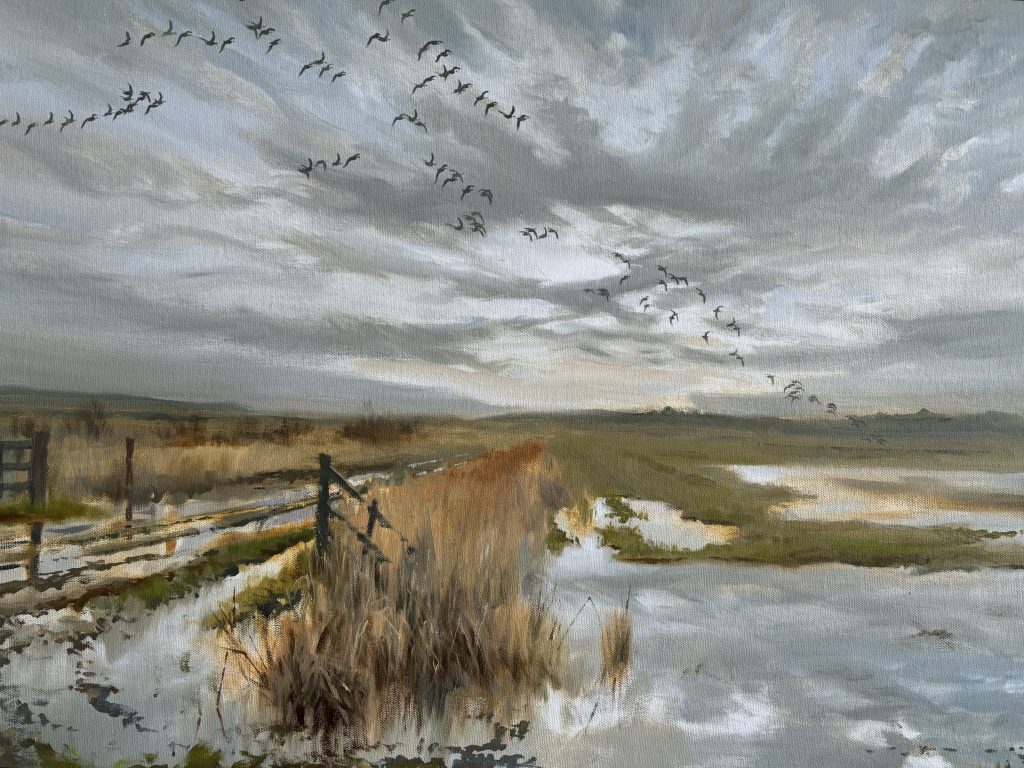
‘The shortening days create restless stirrings in the geese and see them flighting to and fro, as if on preliminary sorties before the journey south begins. The geese fly south in their characteristic skeins, braced against the vagaries of the fearsome North Atlantic storms, to Scotland.’ From there, thousands find their way to North Norfolk, and so begins another autumn here and much rejoicing.
.
The meaning of geese
During lockdown, local author and naturalist Nick Acheson followed the wild geese around North Norfolk on his mother’s old red bicycle, pedalling 1200 miles over seven months, the length of the pinkfoot’s migration from Iceland. On his travels, Nick discovered just what these wild birds mean to people, meeting fellow geese enthusiasts who tell their own stories. His award-winning book, The Meaning of Geese (Chelsea Green Publishing), followed.
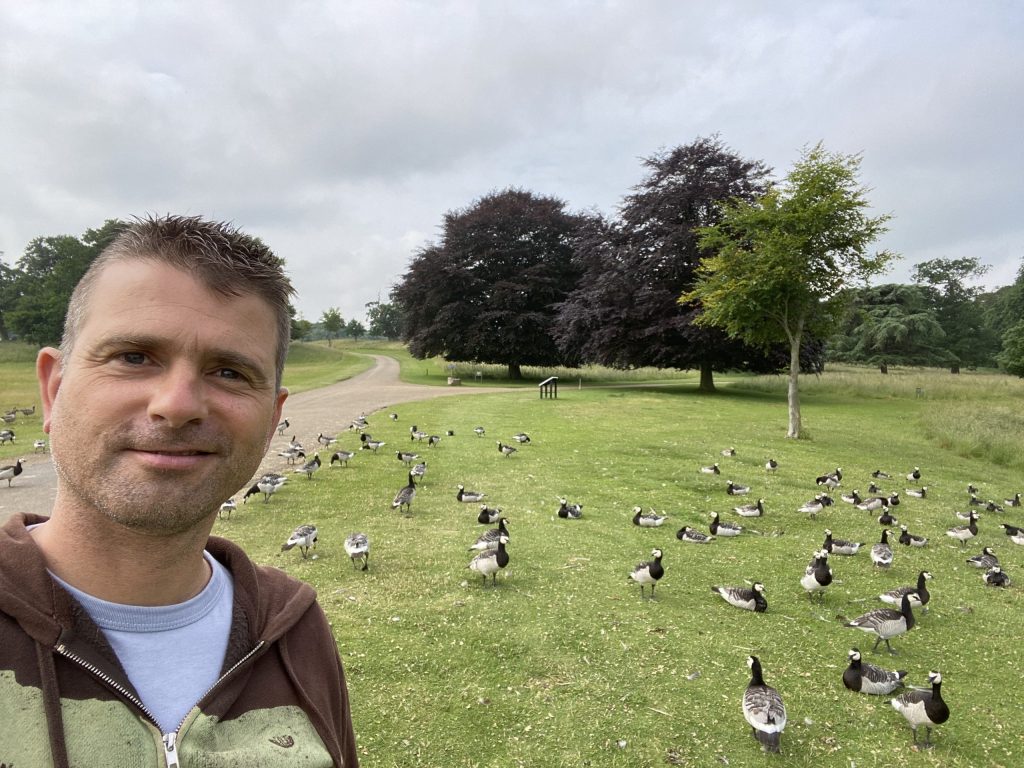
Movingly, at the end of this book, Nick thanks the geese for allowing him to ‘flock’ with them over the winter. His most memorable pinkfeet moment though, he tells me, was of their absence, when he cycled to Holkham and ‘these creatures of the north’ were no longer there. I shared Nick’s joy when I saw him post on Instagram at the beginning of September: ‘Live from Cley, the first 25 pinks are in.’
If you liked this…
Read Sarah Whittley’s review of The Meaning of Geese by Nick Acheson, here





